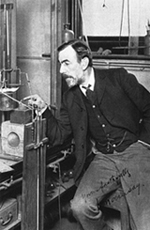
British researchers discover the element krypton. It’s real but will inspire fantastic fiction.
William Ramsay and his student Morris Travers were searching for gases in the helium family. They boiled liquefied air until they got rid of the water, oxygen, nitrogen, helium, and argon. Then they placed the residue in a vacuum tube connected to an induction coil. It produced a spectrum with bright yellow and green lines. Because they had to look for it by removing all that other stuff, Ramsay and Travers gave element number 36 the name krypton, from the Greek kryptos, for “hidden” (think cryptography or encryption).

Within weeks, the dynamic duo detected a duet of other noble gases: neon and xenon. Ramsay was already responsible for discovering helium (with Lord Rayleigh) in 1894 and argon in 1895, giving him ownership of nearly an entire column of the periodic table. He received the 1904 Nobel Prize in Chemistry.
Krypton is used today in high-speed photographic flashes, fluorescent lights, and so-called neon signs (see here) that are greenish yellow. Between 1960 and 1983, krypton wavelengths defined the length of the meter (see here).
When Jerry Siegel and Joe Shuster created Superman in Action Comics no. 1, in 1938, they named their superhero’s home planet after the element discovered forty years earlier. Superman and his legion of fans have made the fictional planet Krypton far better known than the real element. The fictional mineral kryptonite, which threatens Superman’s strength and vitality, even has a real-life counterpart, almost.
Mineralogists in Jadar, Serbia, in 2007 unearthed some sodium lithium boron silicate hydroxide and learned that’s what’s written on a case containing kryptonite in the film Superman Returns. Naming the find kryptonite would violate international nomenclature because it contains no krypton. So they called it jadarite.
Isn’t Jadar Superman’s cousin or something?—RA